Do you dream of creating a unique and standout business concept that will separate your business from the competition when you start it?
You can see many similar products and services in today’s business world. Sometimes, I cannot find the difference when I compare and want to choose a specific product or service. Because of that, I would like to explore some innovative strategies here to increase your imagination, support unconventional thinking, and unlock your true potential.
This article will show you how to develop a creative business concept that grabs attention and drives success. It will provide you with the tools and inspiration to develop a business concept that resonates with your target audience and leaves a lasting impression.
What is a Business Concept?
So, you have a business idea, and now the question is what you must do next. Is it developing a business model or a business plan?
Simply put, you must translate your business ideas into concepts that will help you start or transform your current or future business easier.
The business concepts are written documents that briefly define or outline your new business idea, it doesn’t matter if it is about new company, or a developing a new product or service. You must find all the core elements that define your business in this document.
You can look at the business concept like a one- to three-page business plan summary. Yes, business plans and business concepts aren’t the same things. A business plan is much more detailed in every aspect covered inside business concepts, and you will use this document to give you clear directions when you start working on your business plan.
The primary questions you must respond to in your business concept are the following:
- What is your business idea?
- Why did you come to that specific idea?
- What will your business offer based on the particular business idea?
- Who is the target market for products or services based on that idea?
- What can this business idea do for your target audience?
- Will your target audience be interested in paying money for what you will offer, and why?
- Why do you think that this business idea will make profits?
- What differentiates your idea from others already existing in the market?
- What will be the legal structure of your business?
- How will your business generate income and make money?
Key Elements of the Business Concept
From the questions we covered above, you can easily see the main components that must be included in this document.
1. Short description of your business idea, products, and/or services
Start with a short description of your business idea, like an e-commerce store for clothing (if you still don’t have a business idea, you can choose one from 136 business ideas). Then, explain the product and services you will offer to the market with your business idea.
For example, you can explain what your e-commerce platform will do. Is their integration with AI to help people choose the best fit for them, or do you offer mobile and desktop experiences or only one from them?
2. Target market
Now, you must explain your target audience, what they need and want, and where they are. You must conduct market research to identify your target audience’s demographics, psychographics, and purchasing behavior. Put yourself in their shoes and try to understand their challenges, desires, and aspirations.
You can find more details on how to find the right target market for your small business, then shortly explain your target market inside your business concept.
3. Unique Value Proposition (UVP)
This is one of the most critical elements of your business concept because it represents the unique benefit or set of benefits that differentiate your business from your competitors. So, your UVP is a statement that should answer the question, “Why should potential customers choose you over the competition?“
For example, if you’re launching a food delivery business, your UVP could be “We deliver fresh meals sourced from local farms and prepared with local ethno receipes in under 30 minutes to clients’ homes. As you can see, it is not only delivering food to your house, many business offer such a service to deliver food. So, in this sample, the differentiator is quick delivery (under 30 minutes), meals sourced from local farmers, and prepared with local ethno reciepes.
Follow the steps in this comprehensive guide on how to build a superior value proposition.
4. Competitive differentiation
This is what sets your business apart from others in the same industry. Your competitive advantage could be anything from superior customer service to proprietary technology. A tech startup can have a competitive advantage in its unique AI algorithms that improve user experience.
Here, you must conduct a competitive analysis (answer these 22 questions to help you with this) and create a competitive analysis matrix. You can also use this competitive analysis template, which can be downloaded as an Excel file and will lead you through this analysis.
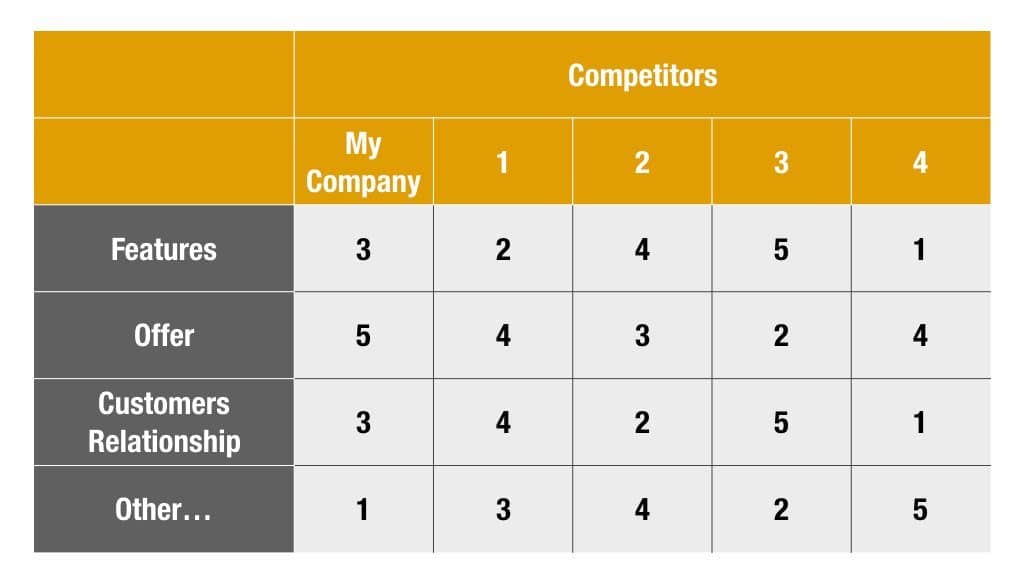
If you want your business concept to effectively be translated into the engine that will make money and profit, you must find ways to be different.
5. Legal structure of your small business
There are four main types of legal structure: sole proprietorship (a business owned and operated only by you), partnership (two or more parties own the company), limited liability company (LLC), and corporation. This is important because your legal structure will impact your small business’s organization, taxation, and accountability.
For example, if you select a partnership, you will have shared decision-making as part of management and organization, and if it is a limited partnership, some or all partners will have limited liability. But, if you choose a corporation, you will have liability protection but not complete control because a board of directors will manage the company. Here is how you can choose the right legal structure for your business.
6. Financial framework
This is not a place where you need to put all your calculations like expected annual revenue, profit and loss statement, cash flow, etc. You will work on them inside your business plan. Here, you must cover the growth potential of your small business through the market size, expected sales based on your target audience, and pricing based on your UVP.
So, the questions you must answer here are the following:
- How will you generate revenue?
- How will you ensure continuous revenue growth?
- How much the product or service development will cost?
7. Launching plan outline
The last element that I always propose to my clients to include in business concepts in this early stage of development of their business ideas is outlining the launching plan. No, again this is not a business plan, this are only several steps you must conduct as a collection of specific business activity that will allow successful launch of your small business, product, or service.
So, in this element, you must outline specific steps to implement your business concept. Here are a few steps to help you successfully implement your creative business concept:
- Product development. Translate your concept into tangible products or services. Ensure that your offerings align with your brand and provide customers with the unique value you promised.
- Marketing and promotion. Develop a comprehensive marketing plan that showcases your concept and effectively reaches your target audience. Use online and offline marketing channels to maximize your reach and create awareness.
- Customer experience. Provide a simple and consistent customer experience that aligns with your business concept. From the moment customers interact with your brand to post-purchase support, every engagement should support your unique value proposition.
- Continuous innovation. Keep growing and change your business concept to stay ahead of the competition and meet the growing needs of your customers.
The Importance of a Creative Concept About Business
As you can see, a creative business concept is the basis upon which successful businesses are built because it will open a clear roadmap of what you must do next for your business idea to become a real small business that will generate enough profit.
Having a creative business concept is an essential tool that you can use to engage with stakeholders and potential investors. If you want to get funding for your small business, the business concept will become an excellent weapon for you in front of potential investors who need to invest money in your company.
Also, while you develop your business concept, you are going through many important aspects of your small business, and understanding those aspects will enable you to create a company that resonates with your target market, making them more likely to choose your products or services over those of your competitors.
A creative business concept also allows you to position your brand as a unique and innovative company.
Tools That Can Help You to Develop a Creative Business Concept
Here are a few techniques to help you think outside the box and generate innovative ideas:
1. Mind Mapping
You can start by writing down your main business idea in the center of a blank paper or some mind-mapping software. Then, branch out and jot down related ideas and concepts like features, additional services, operations, etc. Keep expanding the branches until you have a web of interconnected ideas.
This visual representation can help you see new connections and uncover unique angles for your business concept.
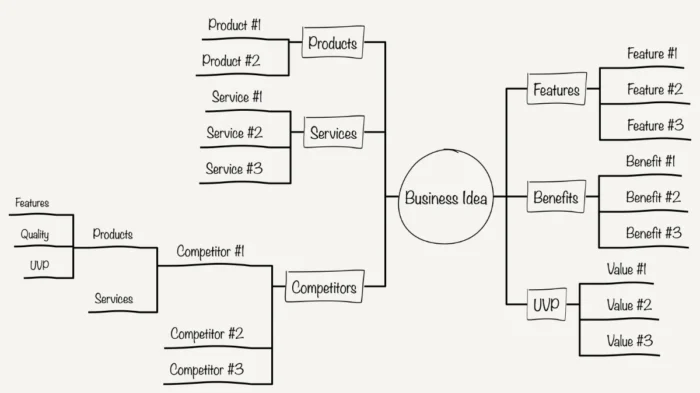
2. Reverse Thinking
Try reversing your assumptions instead of approaching the problem from a conventional perspective. For example, if you’re in the food industry, instead of focusing on what people typically eat, think about what they don’t eat and why.
This reversal can lead to fresh insights and new business opportunities for you.
3. Random Word Association
Pick a random word and try to associate it with your business. This exercise can help you make unexpected connections and find new ideas for your product and service.
For example, if your business is in the fitness industry and the random word is “ocean,” you might brainstorm ideas related to services like water-based workouts or beachside fitness classes.
4. Business Model Canvas (BMC)
This strategic management tool lets you visualize your business model on one page. It includes critical elements such as value proposition, customer segments, channels, customer relationships, revenue streams, key activities, key resources, key partnerships, and cost structure.
Using BMC will help you to understand your business model in a more structured way.
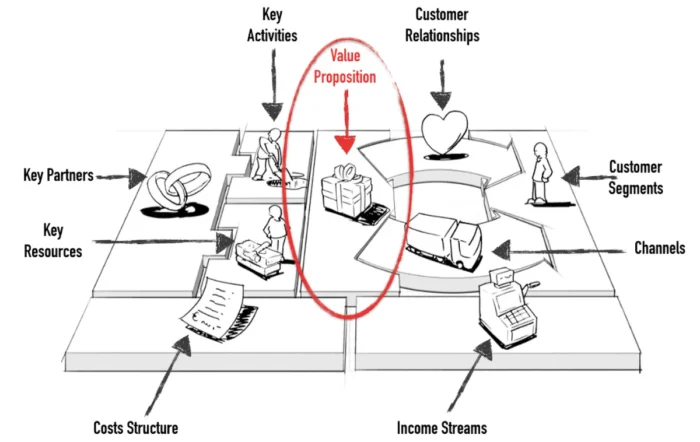
Incorporate Innovation and Uniqueness Into Your Business Concepts
You must incorporate innovation and uniqueness to develop a truly creative business concept. So, you must challenge conventional thinking and explore new approaches to solving new and current problems or meeting customer needs.
Here are a few strategies to help you improve your business concept with innovation:
1. Identify Unmet Needs
Always look for gaps in the market where existing solutions are falling short. When you identify some unmet needs, you can easily create a business concept that fills those gaps and provides a unique value proposition to customers. Follow this guide on how to find a gap in the marketplace.
I have one experience with a client who imports products and sells them as a wholesaler to other companies in the construction sector. One of our questions was how to differentiate his business from the competition. So, we conducted a competitive analysis and learned what they do. This analysis showed us that we could differentiate his business, including better customer support like the membership part of his website called the “Club,” where he offers discounts based on the level and educational videos on how to install the products that his company sells on the market.
2. Analyse Customer Reviews
One of the quickest ways you can find unmet needs or problems is through analysis of customer reviews for your competitor’s products and services. You can see exactly what your customer’s demand is and how they want to satisfy that demand.
Look at one- and two-star reviews on Google Business Profile and TrustPilot. Look at different types of complaints, and they can become possible features for your product or service.
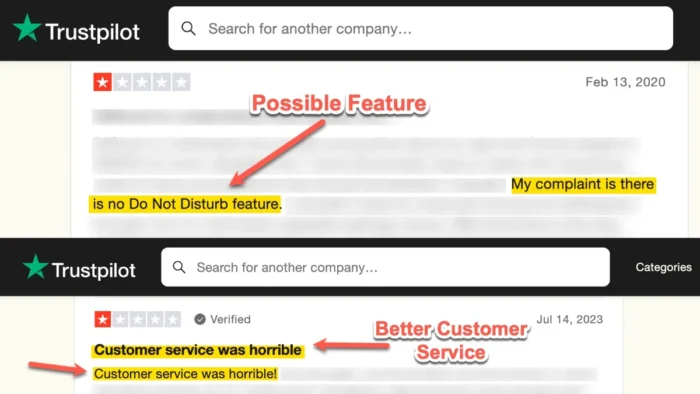
3. Use Technology
We are witnessing significant technological advancements in the last two decades. The new technology opens so many opportunities for companies in different industries. So, you must explore how the latest technology can be integrated into your business concept.
It doesn’t matter if you use artificial intelligence to personalize customer experiences or incorporating blockchain technology for secure transactions, technology can be a powerful tool to differentiate your small business.
4. Collaborate and Co-create
Today, when the experience is most important, you must ensure that you offer a unique customer experience to your target market. However, different persons value different experiences differently. So, one possible way is to involve your target audience in developing your business, the product or service concept.
Open innovation by co-creating with your current or potential customers will help you gain valuable insights into innovative products and services and build a sense of ownership and loyalty among your audience.
You can incorporate a wide-lens perspective to help you implement co-innovation in your company. Read more on how to build powerful innovation networks and partnerships.
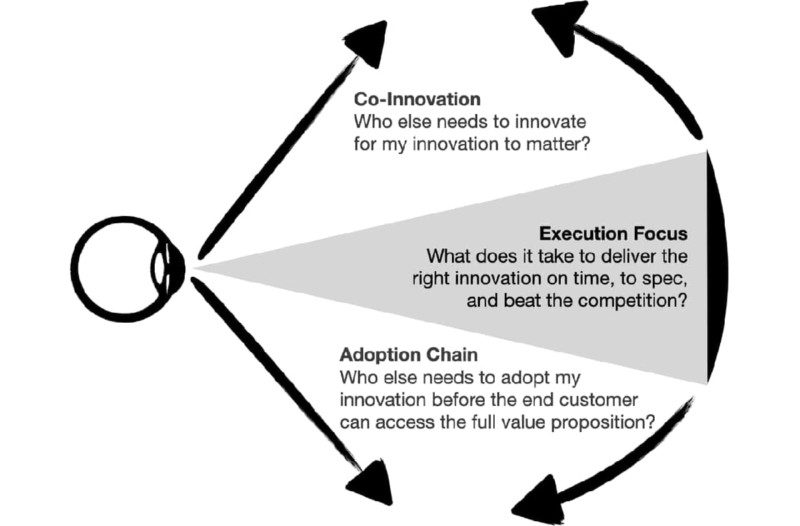
If you always incorporate innovation and uniqueness into your business concept, you’ll create a company that stands out from the competition.
Refining and Testing Your Business Concept
Your business concept is not something that you can do and forget. Remember, the changes in every possible aspect of your business are continuous. Customers are not the same today as yesterday or tomorrow as today. So, you must continuously refine and test your business concept to ensure that your business activity and operations follow changed market conditions.
You can start by revisiting your initial ideas and eliminating elements unaligned with your target audience or market trends. Then, work on reinforcing the unique aspects of your business concept and identify new ways to differentiate your company from competitors on the market.
Always ask for feedback from your target market because it will help you refine your business concept based on real-world insights and ensure it resonates with your target consumers.
Conclusion
As you can see, having only a business idea is not enough. Ideas are not worth it because everyone can have many business ideas, but many will not develop business concepts to continue refining and elaborating on the current business idea.
Your business concept is crucial because it will give you a roadmap on what to do next and help you find investors for your business idea.





